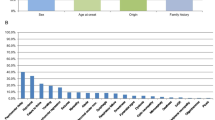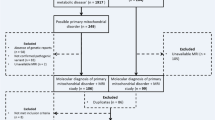Abstract
The knowledge about the genetic spectrum underlying paediatric mitochondrial diseases is rapidly growing. As a consequence, the range of neuroimaging findings associated with mitochondrial diseases became extremely broad. This has important implications for radiologists and clinicians involved in the care of these patients. Here, we provide a condensed overview of brain magnetic resonance imaging (MRI) findings in children with genetically confirmed mitochondrial diseases. The neuroimaging spectrum ranges from classical Leigh syndrome with symmetrical lesions in basal ganglia and/or brain stem to structural abnormalities including cerebellar hypoplasia and corpus callosum dysgenesis. We highlight that, although some imaging patterns can be suggestive of a genetically defined mitochondrial syndrome, brain MRI-based candidate gene prioritization is only successful in a subset of patients.





Similar content being viewed by others
Abbreviations
- ADC:
-
Apparent diffusion coefficient
- CISS:
-
Constructive interference in steady state
- CNS:
-
Central nervous system
- FLAIR:
-
Fluid attenuation inversion recovery
- MELAS:
-
Mitochondrial encephalopathy, lactic acidoses and stroke-like lesions
- MRI:
-
Magnetic resonance imaging
- MRS:
-
Magnetic resonance spectroscopy
- NO:
-
Nitric oxide
- OXPHOS:
-
Oxidative phosphorylation
- PDHC:
-
Pyruvate dehydrogenase complex
References
Bricout M, Grevent D, Lebre AS, Rio M, Desguerre I, De Lonlay P, Valayannopoulos V, Brunelle F, Rotig A, Munnich A, Boddaert N (2015) Brain imaging in mitochondrial respiratory chain deficiency: combination of brain MRI features as a useful tool for genotype/phenotype correlations. J Med Genet 51:429–435
Kevelam SH, Rodenburg RJ, Wolf NI, Ferreira P, Lunsing RJ, Nijtmans LG, Mitchell A, Arroyo HA, Rating D, Vanderver A, van Berkel CG, Abbink TE, Heutink P, van der Knaap MS (2013) NUBPL mutations in patients with complex I deficiency and a distinct MRI pattern. Neurology 80:1577–1583
Lebre AS, Rio M, Faivre d’Arcier L, Vernerey D, Landrieu P, Slama A, Jardel C, Laforet P, Rodriguez D, Dorison N, Galanaud D, Chabrol B, Paquis-Flucklinger V, Grevent D, Edvardson S, Steffann J, Funalot B, Villeneuve N, Valayannopoulos V, de Lonlay P, Desguerre I, Brunelle F, Bonnefont JP, Rotig A, Munnich A, Boddaert N (2010) A common pattern of brain MRI imaging in mitochondrial diseases with complex I deficiency. J Med Genet 48:16–23
Lake NJ, Compton AG, Rahman S, Thorburn DR (2016) Leigh syndrome: one disorder, more than 75 monogenic causes. Ann Neurol 79:190–203
Baertling F, Rodenburg RJ, Schaper J, Smeitink JA, Koopman WJ, Mayatepek E, Morava E, Distelmaier F (2014) A guide to diagnosis and treatment of Leigh syndrome. J Neurol Neurosurg Psychiatry 85:257–265
Leigh D (1951) Subacute necrotizing encephalomyelopathy in an infant. J Neurol Neurosurg Psychiatry 14:216–221
Lake NJ, Bird MJ, Isohanni P, Paetau A (2015) Leigh syndrome: neuropathology and pathogenesis. J Neuropathol Exp Neurol 74:482–492
Medina L, Chi TL, DeVivo DC, Hilal SK (1990) MR findings in patients with subacute necrotizing encephalomyelopathy (Leigh syndrome): correlation with biochemical defect. AJR Am J Roentgenol 154:1269–1274
Valanne L, Ketonen L, Majander A, Suomalainen A, Pihko H (1998) Neuroradiologic findings in children with mitochondrial disorders. AJNR Am J Neuroradiol 19:369–377
Saneto RP, Friedman SD, Shaw DW (2008) Neuroimaging of mitochondrial disease. Mitochondrion 8:396–413
Ross B, Bluml S (2001) Magnetic resonance spectroscopy of the human brain. Anat Rec 265:54–84
Lin DD, Crawford TO, Barker PB (2003) Proton MR spectroscopy in the diagnostic evaluation of suspected mitochondrial disease. AJNR Am J Neuroradiol 24:33–41
Sijens PE, Smit GP, Rodiger LA, van Spronsen FJ, Oudkerk M, Rodenburg RJ, Lunsing RJ (2008) MR spectroscopy of the brain in Leigh syndrome. Brain Dev 30:579–583
Danhauser K, Haack TB, Alhaddad B, Melcher M, Seibt A, Strom TM, Meitinger T, Klee D, Mayatepek E, Prokisch H, Distelmaier F (2016) EARS2 mutations cause fatal neonatal lactic acidosis, recurrent hypoglycemia and agenesis of corpus callosum. Metab Brain Dis 31:717–721
Bonfante E, Koenig MK, Adejumo RB, Perinjelil V, Riascos RF (2015) The neuroimaging of Leigh syndrome: case series and review of the literature. Pediatr Radiol 46:443–451
Giribaldi G, Doria-Lamba L, Biancheri R, Severino M, Rossi A, Santorelli FM, Schiaffino C, Caruso U, Piemonte F, Bruno C (2012) Intermittent-relapsing pyruvate dehydrogenase complex deficiency: a case with clinical, biochemical, and neuroradiological reversibility. Dev Med Child Neurol 54:472–476
El-Hattab AW, Adesina AM, Jones J, Scaglia F (2015) MELAS syndrome: clinical manifestations, pathogenesis, and treatment options. Mol Genet Metab 116:4–12
Yatsuga S, Povalko N, Nishioka J, Katayama K, Kakimoto N, Matsuishi T, Kakuma T, Koga Y (2012) MELAS: a nationwide prospective cohort study of 96 patients in Japan. Biochim Biophys Acta 1820:619–624
Pauli W, Zarzycki A, Krzysztalowski A, Walecka A (2013) CT and MRI imaging of the brain in MELAS syndrome. Pol J Radiol 78:61–65
Ito H, Mori K, Kagami S (2010) Neuroimaging of stroke-like episodes in MELAS. Brain Dev 33:283–288
Ohama E, Ohara S, Ikuta F, Tanaka K, Nishizawa M, Miyatake T (1987) Mitochondrial angiopathy in cerebral blood vessels of mitochondrial encephalomyopathy. Acta Neuropathol 74:226–233
Betts J, Jaros E, Perry RH, Schaefer AM, Taylor RW, Abdel-All Z, Lightowlers RN, Turnbull DM (2006) Molecular neuropathology of MELAS: level of heteroplasmy in individual neurones and evidence of extensive vascular involvement. Neuropathol Appl Neurobiol 32:359–373
Siddiq I, Widjaja E, Tein I (2015) Clinical and radiologic reversal of stroke-like episodes in MELAS with high-dose L-arginine. Neurology 85:197–198
Iizuka T, Sakai F, Suzuki N, Hata T, Tsukahara S, Fukuda M, Takiyama Y (2002) Neuronal hyperexcitability in stroke-like episodes of MELAS syndrome. Neurology 59:816–824
Scaglia F, Wong LJ, Vladutiu GD, Hunter JV (2005) Predominant cerebellar volume loss as a neuroradiologic feature of pediatric respiratory chain defects. AJNR Am J Neuroradiol 26:1675–1680
Holzerova E, Danhauser K, Haack TB, Kremer LS, Melcher M, Ingold I, Kobayashi S, Terrile C, Wolf P, Schaper J, Mayatepek E, Baertling F, Friedmann Angeli JP, Conrad M, Strom TM, Meitinger T, Prokisch H, Distelmaier F (2016) Human thioredoxin 2 deficiency impairs mitochondrial redox homeostasis and causes early-onset neurodegeneration. Brain 139:346–354
Naini A, Lewis VJ, Hirano M, DiMauro S (2003) Primary coenzyme Q10 deficiency and the brain. Biofactors 18:145–152
Baertling F, Haack TB, Rodenburg RJ, Schaper J, Seibt A, Strom TM, Meitinger T, Mayatepek E, Hadzik B, Selcan G, Prokisch H, Distelmaier F (2015) MRPS22 mutation causes fatal neonatal lactic acidosis with brain and heart abnormalities. Neurogenetics 16:237–240
Brito S, Thompson K, Campistol J, Colomer J, Hardy SA, He L, Fernandez-Marmiesse A, Palacios L, Jou C, Jimenez-Mallebrera C, Armstrong J, Montero R, Artuch R, Tischner C, Wenz T, McFarland R, Taylor RW (2015) Long-term survival in a child with severe encephalopathy, multiple respiratory chain deficiency and GFM1 mutations. Front Genet 6:102
Vanderver A, Prust M, Tonduti D, Mochel F, Hussey HM, Helman G, Garbern J, Eichler F, Labauge P, Aubourg P, Rodriguez D, Patterson MC, Van Hove JL, Schmidt J, Wolf NI, Boespflug-Tanguy O, Schiffmann R, van der Knaap MS (2014) Case definition and classification of leukodystrophies and leukoencephalopathies. Mol Genet Metab 114:494–500
Baertling F, Schaper J, Mayatepek E, Distelmaier F (2013) Teaching neuroimages: rapidly progressive leukoencephalopathy in mitochondrial complex I deficiency. Neurology 81:e10–e11
Huemer M, Karall D, Schossig A, Abdenur JE, Al Jasmi F, Biagosch C, Distelmaier F, Freisinger P, Graham BH, Haack TB, Hauser N, Hertecant J, Ebrahimi-Fakhari D, Konstantopoulou V, Leydiker K, Lourenco CM, Scholl-Burgi S, Wilichowski E, Wolf NI, Wortmann SB, Taylor RW, Mayr JA, Bonnen PE, Sperl W, Prokisch H, McFarland R (2015) Clinical, morphological, biochemical, imaging and outcome parameters in 21 individuals with mitochondrial maintenance defect related to FBXL4 mutations. J Inherit Metab Dis 38:905–914
Wortmann SB, Zietkiewicz S, Kousi M, Szklarczyk R, Haack TB, Gersting SW, Muntau AC, Rakovic A, Renkema GH, Rodenburg RJ, Strom TM, Meitinger T, Rubio-Gozalbo ME, Chrusciel E, Distelmaier F, Golzio C, Jansen JH, van Karnebeek C, Lillquist Y, Lucke T, Ounap K, Zordania R, Yaplito-Lee J, van Bokhoven H, Spelbrink JN, Vaz FM, Pras-Raves M, Ploski R, Pronicka E, Klein C, Willemsen MA, de Brouwer AP, Prokisch H, Katsanis N, Wevers RA (2015) CLPB mutations cause 3-methylglutaconic aciduria, progressive brain atrophy, intellectual disability, congenital neutropenia, cataracts, movement disorder. Am J Hum Genet 96:245–257
Author information
Authors and Affiliations
Corresponding author
Ethics declarations
Funding
This project was supported by the BMBF-funded German Network for Mitochondrial Disorders (mitoNET #01GM1113C) and by the E-Rare project GENOMIT (01GM1207). TBH was supported by the BMBF through the Juniorverbund in der Systemmedizin “mitOmics” (FKZ 01ZX1405C). FD was supported by a grant of the Forschungskommission of the Medical Faculty of the Heinrich-Heine-University Düsseldorf. FB was supported by a grant of the German Research Foundation/Deutsche Forschungsgemeinschaft (BA 5758/1-1).
Conflict of interest
None.
Rights and permissions
About this article
Cite this article
Baertling, F., Klee, D., Haack, T.B. et al. The many faces of paediatric mitochondrial disease on neuroimaging. Childs Nerv Syst 32, 2077–2083 (2016). https://doi.org/10.1007/s00381-016-3190-3
Received:
Accepted:
Published:
Issue Date:
DOI: https://doi.org/10.1007/s00381-016-3190-3




